As we move deeper into 2025, the conversation around data protection has fundamentally shifted. What was once a straightforward discussion about backup and recovery has evolved into something far more complex: data resilience.
For Managed Service Providers (MSPs) protecting dozens or even hundreds of client environments, this shift isn’t just semantic. It represents a critical evolution in how we think about safeguarding business continuity in an era of escalating cyber threats.
To understand where MSPs stand on this journey, BDRShield conducted a comprehensive survey in September 2025, gathering insights from hundreds of MSPs across the globe.
Quick Takeaways: MSP Data Resilience in 2025
- 76% of MSPs struggle with rising backup costs
- 17% of MSPs have already transitioned to data resilience strategies
- Ransomware protection remains a critical concern for 62% of MSPs
- Immutable backups are now the #1 priority (72% adoption)
- Cloud-managed and on-premises management show nearly equal preference
Survey Overview
Our respondents represent a diverse cross-section of the MSP community, serving anywhere from fewer than 10 clients to established firms managing 200+ client environments. They came from 100+ countries spanning five continents, bringing perspectives shaped by different regulatory landscapes, threat environments, and market conditions.
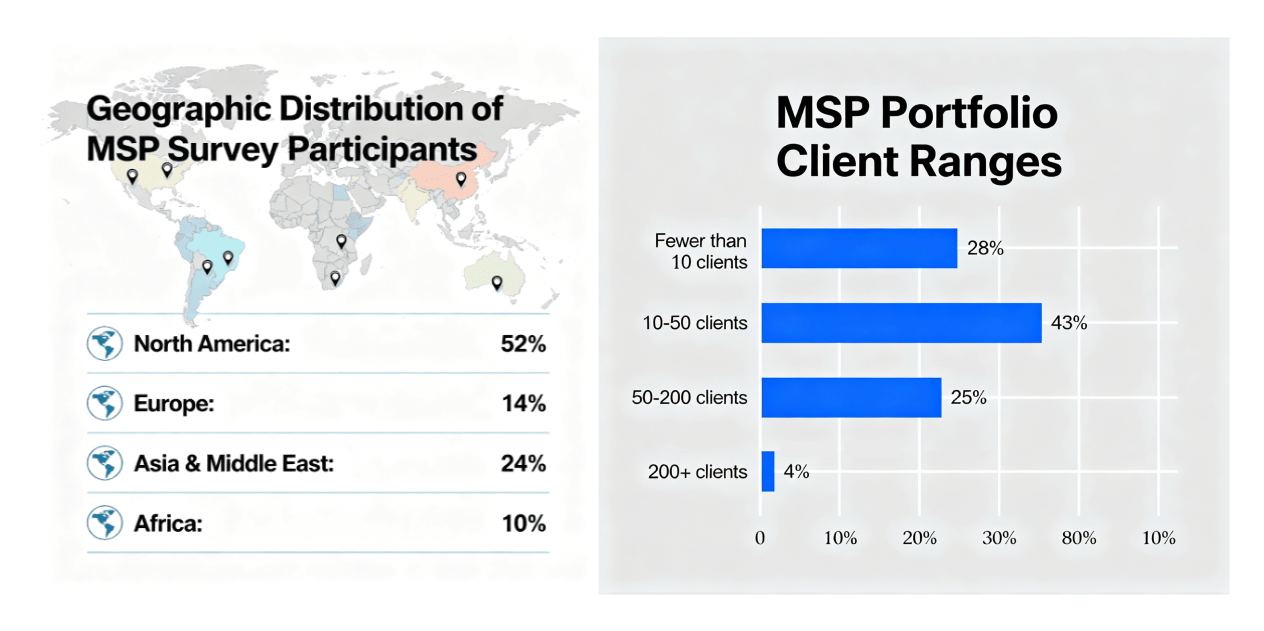
Why This Survey Matters: Understanding MSP backup challenges, data resilience adoption rates, and feature priorities helps service providers benchmark their strategies against industry trends and identify gaps in their current data protection approaches.
Top Backup Challenges for MSPs in 2025
When asked about their most pressing backup challenges, the responses revealed a complex web of pressures facing today’s MSPs.
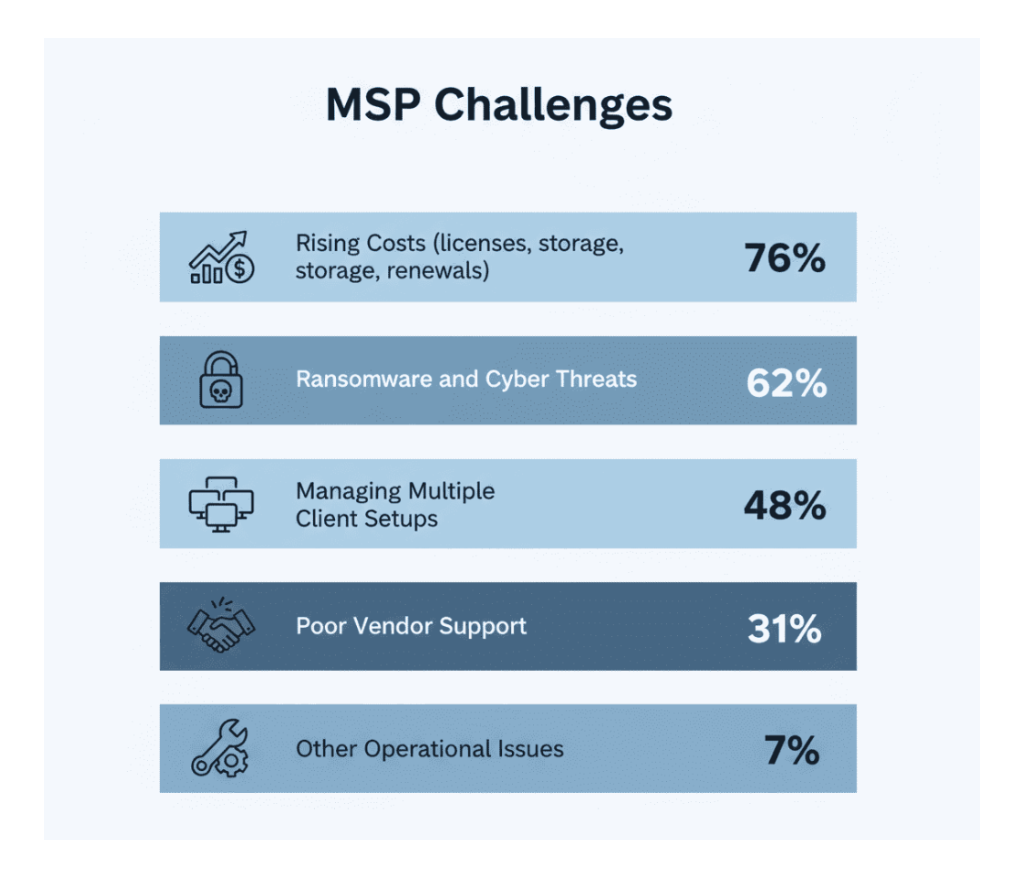
Key Finding: Cost pressures are universal across MSPs of all sizes. Rising licensing fees, storage costs, and renewal prices create budget strain, while ransomware threats simultaneously demand increased security investments—creating a difficult financial paradox.
How Many MSPs Have Adopted Data Resilience Strategies?
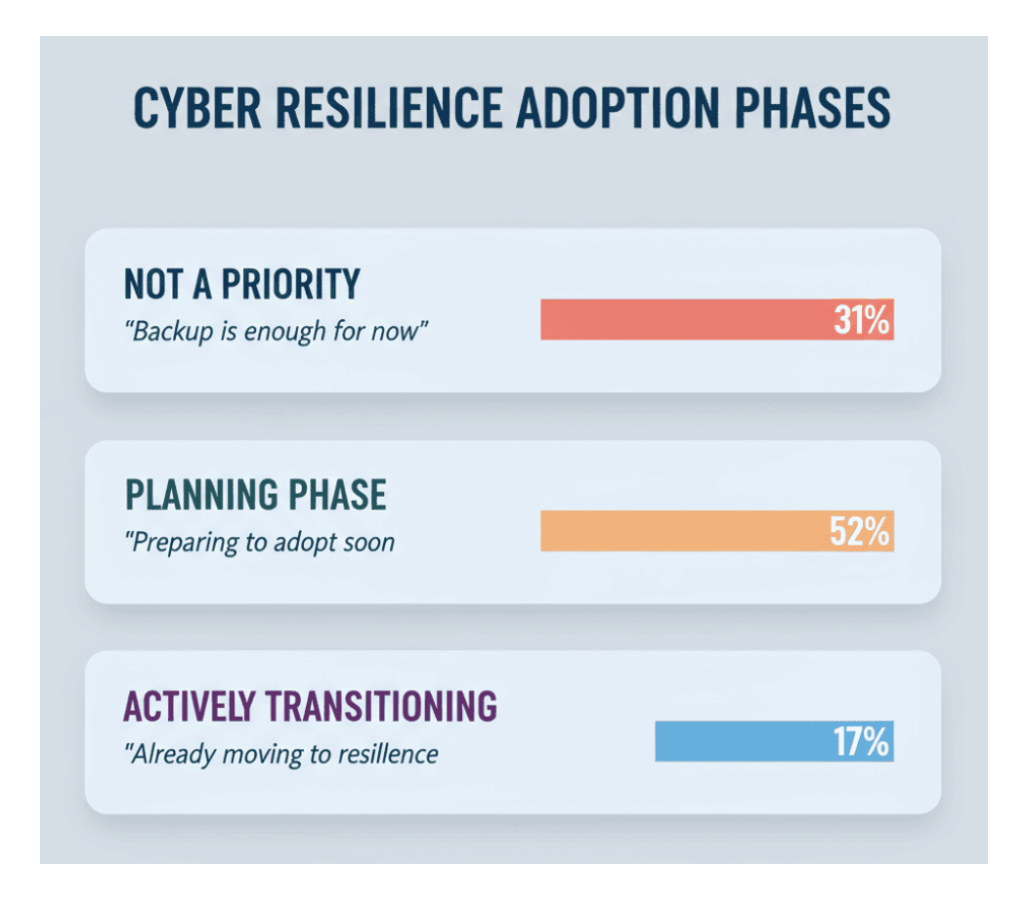
Critical Insight: While 52% of MSPs are planning to adopt data resilience approaches, only 17% are actively implementing these strategies. This suggests most MSPs recognize the need but face barriers—likely budget constraints, resource limitations, or uncertainty about implementation.
What Is the Difference Between Backup and Data Resilience?
Backup just makes copies of your data so you can restore it if something goes wrong. Data resilience goes further—it keeps your data safe from threats, helps you recover quickly, and ensures your business keeps running even during problems.
Why Aren’t More MSPs Transitioning to Data Resilience?
Common barriers preventing data resilience adoption include:
- Budget constraints: Upfront investment concerns
- Knowledge gaps: Uncertainty about implementation strategies
- Competing priorities: Other pressing IT initiatives
- Change resistance: Comfort with existing backup workflows
- Vendor limitations: Current platforms lack resilience features
Most Important Data Resilience Features for MSPs
When we asked about essential features for data resilience, clear priorities emerged.
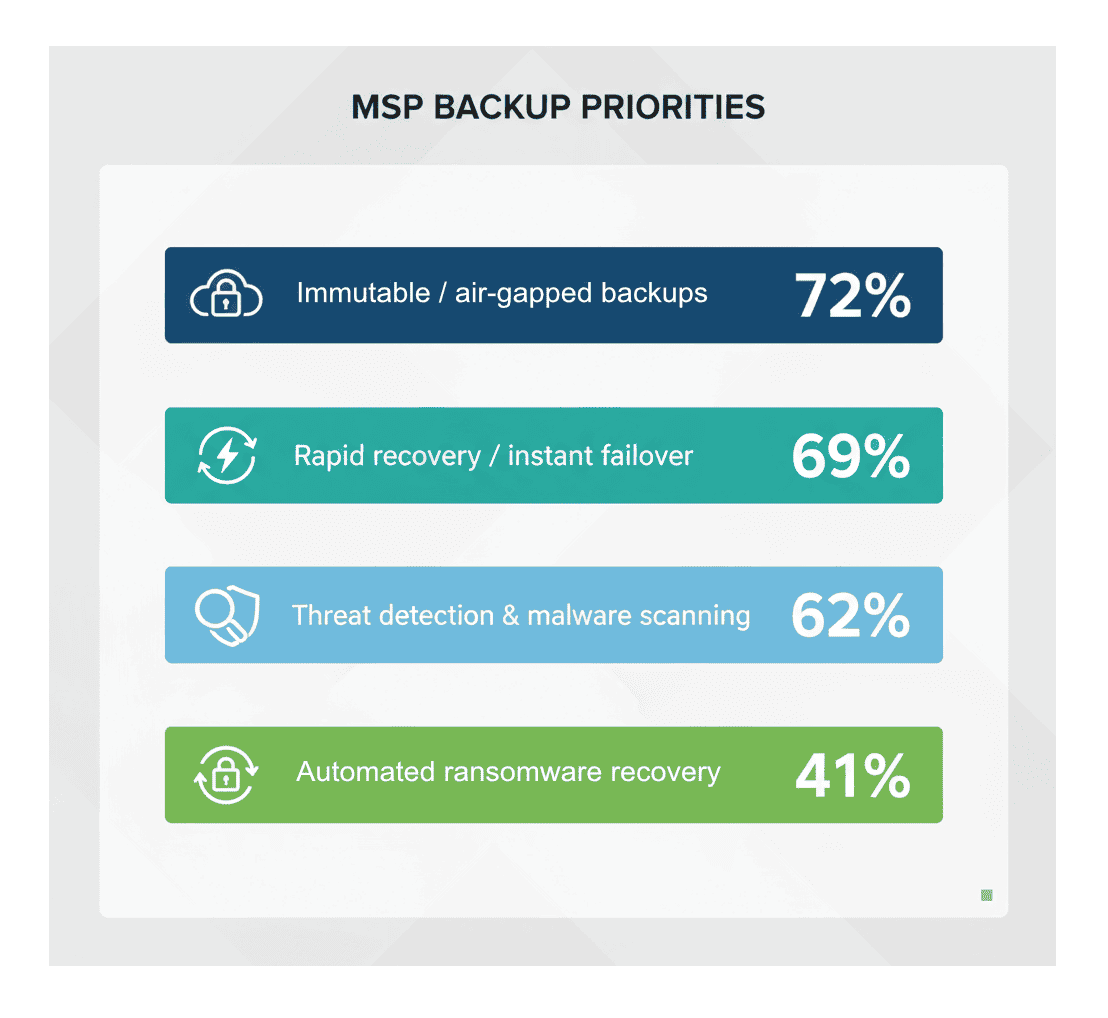
Why Are Immutable Backups Critical for MSP Data Protection?
Immutable backups topped the priority list at 72%, reflecting mature understanding that modern ransomware specifically targets backup repositories. Immutability ensures that once data is written, it cannot be altered or deleted—even by administrators or ransomware with elevated privileges.
Benefits of immutable backup storage:
- Protection against ransomware encryption
- Compliance with WORM (Write Once, Read Many) requirements
- Prevents accidental or malicious deletion
- Ensures clean recovery points are always available
How Fast Should Recovery Be?
69% of MSPs prioritize rapid recovery and instant failover, understanding that resilience isn’t just about protection—it’s about minimizing downtime. Modern RTO (Recovery Time Objective) expectations have compressed dramatically:
- Traditional backup: Hours to days for full recovery
- Modern resilience: Minutes to hours with instant failover
- Best practice: Less than 15-minute RTOs for critical workloads
What Is Automated Ransomware Recovery?
Automated ransomware recovery (prioritized by 41% of MSPs) represents the next evolution in data protection. Instead of manual identification of clean backup points and restoration, automated systems:
- Detect ransomware signatures in backup data
- Identify the last clean backup point automatically
- Orchestrate recovery workflows without manual intervention
- Verify data integrity post-recovery
Cloud vs. On-Premises: How Do MSPs Prefer to Manage Backups?
MSPs show nearly equal preference between cloud-managed and on-premises backup management.
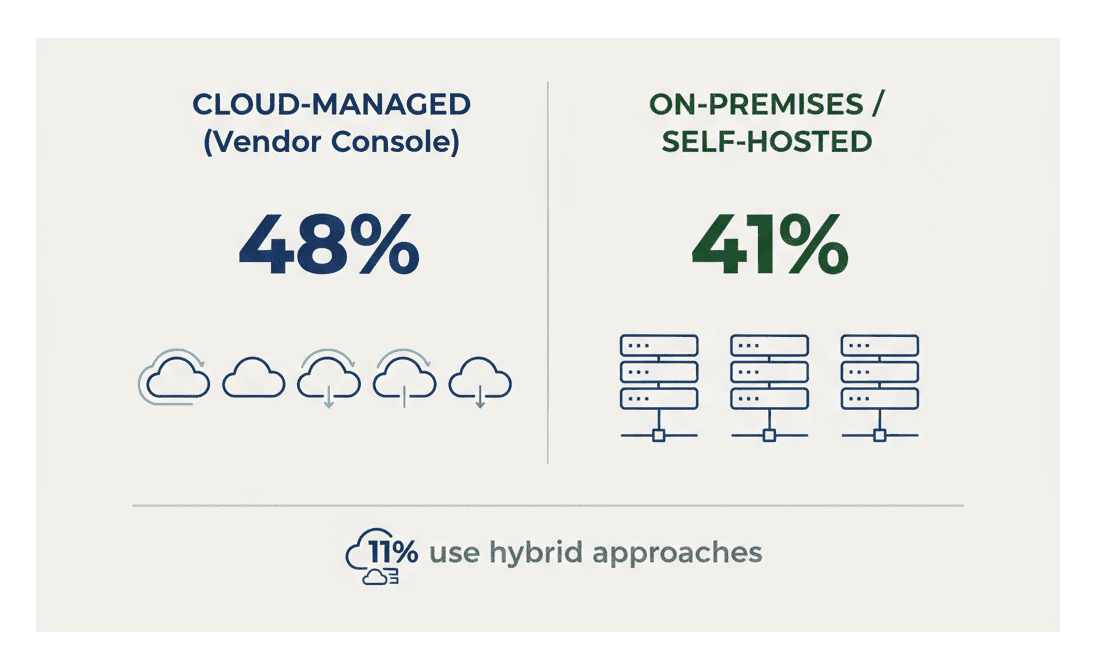
| Cloud-Managed Backup | On-Premises Backup |
|---|---|
| Lower infrastructure overhead | Complete control over infrastructure |
| Automatic updates & maintenance | Data sovereignty compliance |
| Manage from anywhere, anytime | Lower long-term costs for large setups |
| Scalable without hardware | Faster local recovery |
| Geographic redundancy built-in | Custom integration options |
| Best for: MSPs with limited IT staff, SMB clients, or those prioritizing efficiency | Best for: MSPs in regulated industries or with existing infrastructure investments |
How Will Data Resilience Evolve Beyond 2025?
The shift from backup to data resilience isn’t just a marketing evolution—it’s a fundamental rethinking of how we protect business-critical data in an era where cyberattacks are a question of “when”, not “if.”
- AI-driven threat intelligence: Machine learning will predict and prevent attacks before they occur
- Zero-trust backup security: Continuous verification of backup integrity and access
- Ransomware negotiation features: Built-in incident response and recovery orchestration
- Compliance automation: Automated documentation for audits and regulations
- Recovery testing as a service: Automated validation of backup recoverability
Key Takeaways: MSP Backup and Data Resilience in 2025
- 76% of MSPs cite rising costs as their top challenge—budget pressure is universal across the industry
- Only 17% are actively transitioning to data resilience strategies—there’s a massive readiness gap requiring immediate attention
- 72% prioritize immutable backups—immutability is now table stakes, not an optional feature
- Nearly even split between cloud-managed (48%) and on-premises (41%) preferences—flexibility is essential
- 62% face ransomware threats—cyber resilience features are no longer nice-to-have but critical requirements
BDRShield’s Approach to Data Resilience
What Makes BDRShield Different from Traditional Backup Platforms?
The growing adoption of solutions like BDRShield alongside traditional players shows that MSPs are actively seeking alternatives to better manage costs, complexity, and security. BDRShield delivers this with a cost-effective, cloud-managed hybrid backup solution featuring built-in cyber resilience for reliable, secure, and efficient data protection.
How BDRShield solves the core challenges MSPs face
| Challenge | BDRShield’s Solution |
|---|---|
| Cost | Industry-low pricing, simple per-workload pricing, no contracts or targets, one edition for all. |
| Ransomware Threats | Immutable & air-gapped backups, anomaly detection, malware scanning, MFA, encryption. |
| Multi-Client Management | Multi-tenant console, PSA/RMM integration, cloud-based remote management, web-services API, branding. |
| Support Gaps | 24/7 tech support, dedicated account manager, training & certification, and comprehensive documentation. |
Next Step for MSPs: Get Started with Data Resilience
If you’re among the 52% of MSPs still in the planning phase for data resilience, or part of the 76% struggling with rising backup costs, now is the time to evaluate BDRShield.
Follow our Twitter and Facebook feeds for new releases, updates, insightful posts and more.



Leave A Comment